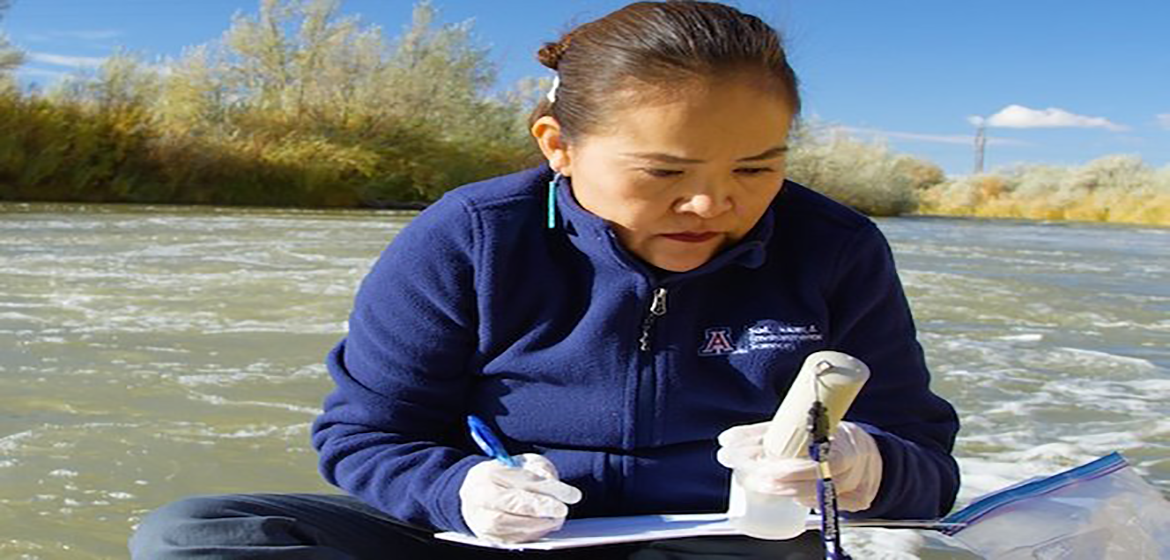By Emily V. Driscoll
A new film highlights the efforts of a Diné hydrologist to protect sacred waters
In August of 2015, members of the Navajo, or Diné, Nation watched “in horror” as a yellow plume of 3 million gallons of acid mine drainage rushed into their major water supply—the San Juan River. EPA contractors had been investigating the abandoned Gold King Mine near Silverton, Colorado, when they disturbed a plug holding back millions of gallons of heavy metal–laden water. Karletta Chief, a University of Arizona hydrologist, and member of the Diné community, learned of the spill at the same time as many in the region—two days after it occurred and when it reached the farms of the Navajo Nation. In that moment, she dedicated herself to finding ways to help communities contend with the spill and protect against future ecological disasters.
Chief’s research and efforts to protect the sacred waters of the Navajo Nation are featured in Breakthrough: Bitter Water, a film I directed and co-produced with Science Friday producer Luke Groskin. It’s the final film in the Science Friday/ Howard Hughes Medical Institute (HHMI) six-part anthology, Breakthrough: Portraits of Women in Science. The series features women in STEM fields at the forefront of their careers, and includes films about scientists of India’s Mars Orbiter Mission (MOM), a “killer snail chemist” and a USGS wildlife biologist who studies polar bear populations in the changing Arctic. The films are published on Science Friday’s website and will be shown at select Alamo Drafthouse theaters around the country in March 2018 during Women’s History Month.
Chief grew up on Black Mesa, an area of the Navajo Nation in Northern Arizona near the Four Corners region, and viewed water as a sacred and scarce resource. As a child she lived without electricity and running water. Her chores included carrying gallons of water up a hill from the well to her parent’s house. “It was quite strenuous,” she recalls. She also has early memories of mining impacts on her family—including a coal mine explosion that set her grandmother’s corral on fire, causing her family to lose their house. In another instance, 100 of her family’s sheep died after drinking water contaminated by the mine.
Growing up near a mine isn’t unique on the Navajo Nation, as there are over 1,000 mines, extracting uranium, coal and other natural resources. From an early age, Chief wanted to help her family and community. She was the first in her immediate family to go to college and then continued her studies, receiving her PhD in hydrology and water resources from the University of Arizona in 2007.
After the Gold King Mine spill, many in the Diné community were devastated and worried about using the water, which they view as a “sacred being” and rely on for their livelihoods. They depend on the river for spiritual and cultural practices, as well as for farming and irrigating crops. A risk assessment was conducted shortly after the spill and found water levels safe for recreational use, but Diné members were skeptical. In a November 7, 2017 community event “Sharing stories across the Watershed” in Durango, Colorado, Duane “Chili” Yazzie, president of the Shiprock Chapter of the Navajo Nation, read a poem he’d written about the disaster and its immediate aftermath: “Water must be okay, bye bye bye. Who do we believe? They all sound the same. Maybe it is okay? How do we know for sure?”
Within a year of the spill, Chief herself explored the unique ways that the Diné could be exposed to contaminants in the river, by surveying the communities. She found that her people use the river in more than 400 ways, including cultural, medicinal and spiritual practices, such as putting river clay on their face for prayers and collecting and crafting reeds for baskets. This survey illustrated the potential exposure pathways for Navajo community members not captured in the recreational risk assessment. Chief's knowledge of the culture and the community led to further scientific insights that other studies didn’t take into account.
In her short-term study of three communities along the San Juan River, Chief took water samples to measure concentrations of arsenic and lead. Her findings indicated low levels of the metals that “are not of concern to human health,” but she cautioned that spikes occur during snow melt, when sediments are stirred up. In the months and years since the spill, she’s organized and participated in “teach-ins” across communities along the river to translate scientific findings to Navajo community members and address their concerns.
Chief is in the middle of a long-term study that includes analyzing sediment core samples in and along the river, irrigation ditches and agricultural soil and examining levels of arsenic and lead in corn and sheep samples. Her work continues to point to the importance of designing studies that take into account different ways people can be exposed to contaminants based on how they interact with their environment. Watch Breakthrough: Bitter Water for more on Karletta Chief and protecting the sacred waters of the Navajo Nation.
Source:
Related to SDG 14: Life below water and SDG 10: Reduced inequalities



